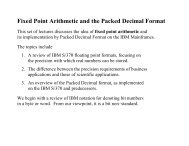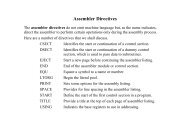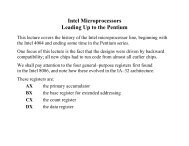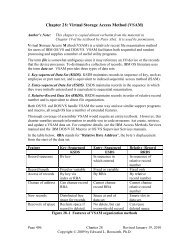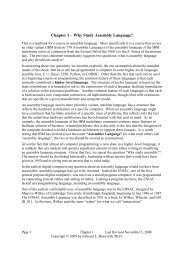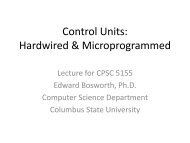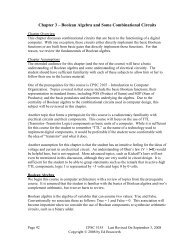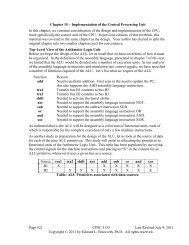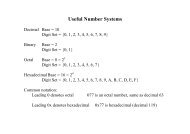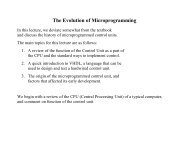PDF Version - Edwardbosworth.com
PDF Version - Edwardbosworth.com
PDF Version - Edwardbosworth.com
You also want an ePaper? Increase the reach of your titles
YUMPU automatically turns print PDFs into web optimized ePapers that Google loves.
S/370 Assembler Language Binary Integer Data<br />
Single Register Left Shifts: Another View<br />
First consider the left shifts. There are two single–register variants: SLL and SLA.<br />
For an N–bit logical left shift, bits 0 through (N – 1) are shifted out of the register<br />
and discarded. Bits 31 through (32 – N) are filled with 0.<br />
Bit 0 is not considered as a sign bit in a logical shift; it may change values.<br />
For an N–bit arithmetic left shift, bits 1 through N are shifted out of the register<br />
and discarded. Bits 31 through (32 – N) are filled with 0. Bit 0 (the sign bit)<br />
is not changed.<br />
The overflow bit can be set by an arithmetic left shift. This will occur if<br />
the bit shifted out does not match the sign bit that is retained in bit 0.<br />
We shall see later that setting the overflow bit indicates that the result of the<br />
shift cannot be viewed as a valid result of an arithmetic operation.<br />
Single Register Right Shifts: Another View<br />
Now consider the left shifts. There are two single–register variants: SRL and SRA.<br />
For either of these shift types, a shift by N bit will cause the N least significant bits<br />
to be shifted out of the register and discarded.<br />
For an N–bit logical right shift, the value 0 is shifted into the N most significant bits,<br />
bits 0 through (N – 1) of the register. Bit 0 is not considered a sign bit and is<br />
shifted into bit N of the register. The sign of the number may change.<br />
For an N–bit arithmetic right shift, bit 0 is considered as a sign bit. Bit 0 is not changed,<br />
but is shifted into bits 1 through N of the register. At the end, the (N + 1) most<br />
significant bits of the register contain what used to be bit 0 (the sign bit).<br />
For an arithmetic right shift, the sign of the shifted result is the same as that of the<br />
original. If the sign bit originally is 0, the SRL and SRA produce identical results.<br />
Page 240 Chapter 12 Last Revised July 6, 2009<br />
Copyright © 2009 by Edward L. Bosworth, Ph.D.



